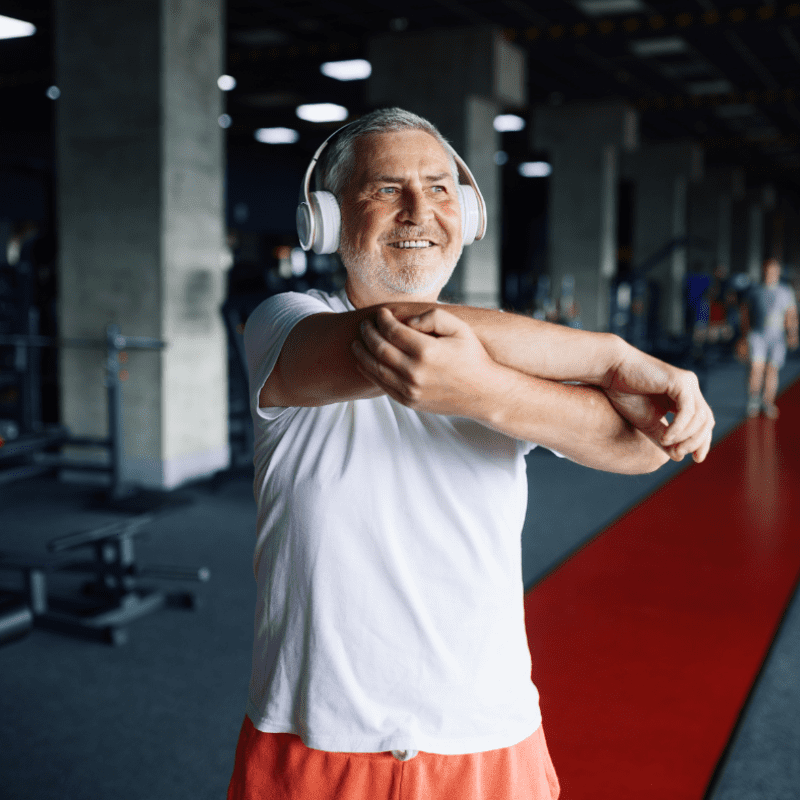If it was a pill, exercise would be prescribed for almost every ailment known to mankind. It’s that beneficial. It’s common knowledge that physical movement has unparalleled power to improve a person’s physical health. We now also know that, because your body and mind are integrally connected, it’s also excellent for your brain and, in turn, your mental health.
Sedentary lifestyles increase all causes of mortality, double the risk of cardiovascular diseases, diabetes, and obesity, and increase the chances of colon cancer, high blood pressure, osteoporosis, lipid disorders, depression, and anxiety. According to the World Health Organization, physical inactivity is the fourth leading cause of death.
The bottom line is your brain needs you to move your body to stay healthy. The science is abundant and overwhelmingly clear that exercise improves many facets of brain and mental health. Here are eight key ways that exercise positively impacts them.
Increases blood flow
Physical activity promotes better blood circulation, which means more oxygen and nutrients are delivered to your brain. The enhanced blood flow supports brain health and function in many ways. Increased blood flow elevates oxygen levels which triggers helpful biochemical changes. It stimulates the production of brain-derived neurotrophic factor (BDNF), a protein that promotes the growth and protection of brain cells (neurons). You can think of BDNF as fertilizer for your brain cells. Higher levels of BDNF are associated with improved memory, learning, and cognitive function.
Just like your muscles, your brain cells need to be stressed to grow, and doing complicated activities requiring coordination, movement, and thought challenges them and enhances attention and concentration. For this reason, activities that require you to move and think at the same time, like tennis, yoga, or choreographed dancing, provide the biggest brain boost. If you exercise in ways that disengage your brain from actively participating, you’re getting the physical benefits of increased blood flow and oxygen to the brain and the release of feel-good, stress-reducing neurochemicals, but you’re losing out on major opportunities for mental gains. Surprisingly, some of the strongest brain benefits are seen with swimming.
Research confirms that increasing physical activity and physical fitness improves academic performance. Even brief sessions of activity, like recess, have significant benefits. Researchers found that a single 20-minute workout can produce mood benefits lasting as long as 12 hours.
Enhances mood and mental health
Physical activity has been proven to ease the symptoms of depression and anxiety and improve mood and overall mental health. A better mood and mental state positively impact a person’s cognitive abilities too because exercise triggers the release of neurotransmitters, including endorphins, dopamine, and serotonin, which aid learning and memory. The science tells us:
- One study found people who worked out that day were more productive and happier.
- An eleven-year Harvard study found that adults over 50 who possessed psychological well-being, measured by positive emotions and optimism, were more likely to be physically active.
- Most of us have heard of the “runner’s high” caused by feel-good hormones called endorphins. Any exercise can stimulate similar endorphin release — even stretching and yoga.
- One study found that just three sessions of yoga per week boosted participants’ levels of the brain chemical GABA, which generally translates into improved mood and decreased anxiety.
Improves sleep
Regular exercise can lead to better sleep quality and duration which helps your brain health and cognition. Adequate sleep is essential for brain restoration and the consolidation of memories. Researchers don’t completely understand all the intricacies of how physical activity improves sleep. However, science does know that exercise aids in synchronizing circadian rhythms, reducing cortisol levels, decreasing REM sleep, and causing many favorable neurochemical changes in your brain.
Research also confirms that moderate aerobic exercise increases the amount of slow-wave sleep you get. Slow-wave sleep refers to phase 3 sleep, which is the deepest phase of non-rapid eye movement sleep and is characterized by delta waves. Slow-wave sleep is important for memory consolidation, and it’s when the brain and body rejuvenate. Exercise can also help stabilize your mood and decompress a busy brain, which is a cognitive prerequisite for falling and staying asleep.
It has been suggested that exercising too close to bedtime, typically, two or three hours before, can raise your body temperature and heart rate and keep you awake. However, some studies found the exact opposite to be true. So, do what works best for you. You can never go wrong with a relaxing exercise, like yoga and stretching before bed.
Encourages neuroplasticity and neurogenesis
Exercise encourages your brain to grow and change by forming new brain cells, neural pathways, and synaptic connections. Neuroplasticity is the ability of your brain to alter its physical form and function in response to experience and learning. Neurogenesis is the birth of new brain cells.
It used to be believed that both processes only happened in young brains. However, we now know that your brain is capable of change and growth throughout your life. Physical activity improves neuroplasticity because it increases neurotrophic factors (like BDNF) and receptor production. Aerobic activity is the single most effective way of boosting neurogenesis.

Relieves clinical symptoms of anxiety and depression
Researchers have also examined the effects of exercise on measurable brain function and symptoms of depression and anxiety. Studies suggest regular exercise has a moderate effect on depressive symptoms comparable to psychotherapy. One Harvard study showed that exercise is every bit as powerful as medication for treating the symptoms and root causes of depression. Another meta-analysis said this:
“The mechanisms underlying the antidepressant effects of exercise remain in debate; however, the efficacy of exercise in decreasing symptoms of depression has been well established. Data regarding the positive mood effects of exercise involvement, independent of fitness gains, suggest that the focus should be on the frequency of exercise rather than duration or intensity until the behavior has been well established. The addition of self-monitoring techniques may increase awareness of the proximal benefits of exercise involvement, which is generally reinforcing to the patient.”
For anxiety disorders, the effect is mild to moderate. In a study conducted with refugee children, researchers found a reduction in symptoms of anxiety and PTSD in children who attended eight to twelve weeks of dance and movement therapies. John Ratey MD, writes in the Harvard Health article, “Can exercise help treat anxiety?”
“As a psychiatrist who studies the effects of exercise on the brain, I’ve not only seen the science, I’ve witnessed firsthand how physical activity affects my patients. Research shows aerobic exercise is especially helpful. A simple bike ride, dance class, or even a brisk walk can be a powerful tool for those suffering from chronic anxiety.”
You can incorporate regular exercise into your life as an effective preventative and treatment for depression. Moderate exercise also has anti-inflammatory effects. This is important, given the new insights into the potential role of inflammation in anxiety and depression.
Reduces stress
Chronic stress damages your brain. Too much stress can cause physical changes to the hippocampus, your brain’s memory center, due to a surplus of glutamate, a signaling neurotransmitter, and cells die off resulting in memory loss. Also, over time, cortisol, the stress hormone, builds direct pathways between the hippocampus and amygdala, your brain’s fear center, forming a stress loop. This creates a brain that’s persistently in a heightened fight-or-flight state.
Endorphins produced during physical activity act as stress relievers by reducing cortisol levels and promoting your nervous system’s relaxation response. During exercise, testosterone levels increase which also buffers the effects of psychological stress. Exercise also reduces stress and anxiety by increasing soothing brain chemicals, like endorphins and GABA. Antibodies are elevated strengthening your immune system, and endocannabinoids are released, which play a role in pain sensation, mood, and memory.

Lowers risk of neurodegenerative diseases
Many studies confirm that exercising regularly helps protect both brain and memory health as you age. Science recommends exercise as a neuroprotective activity and one of the best ways to lower your risk of dementia, Alzheimer’s, and Parkinson’s by as much as 45 percent. Science suggests that it may have this effect because it helps maintain healthy insulin and body mass index levels which, in turn, preserve brain volume and ward off dementia.
Exercise protects your hippocampus, the part of your brain which governs memory and spatial navigation, which is the first brain area to degrade with Alzheimer’s. Studies with twins showed exercise can reduce dementia risks even when there is a genetic predisposition. To summarize the research:
- Low levels of physical activity are associated with an increased risk of Alzheimer’s.
- Older adults who exercise are more likely to maintain healthy cognition longer.
- Exercise modulates amyloid β (the main component of the amyloid plaques found in the brains of people with Alzheimer’s) turnover, inflammation, synthesis, and release of neurotrophins, and cerebral blood flow.
Even babies of mothers who exercise during pregnancy are born with more mature brains. The evidence states that physical exercise is the best way to get and keep your brain and body healthy at any age.
Better executive function
Neurological tests and neuroimaging widely support that regular physical activity leads to positive effects on multiple cognitive functions at every stage of life. A healthy lifestyle and regular exercise reduce inflammation, increase the presence of neurotrophic factors essential for vital brain processes; improve cognitive abilities, and enhance functional connectivity of brain areas. Research shows that aerobic exercise improves cognition in youth and middle-aged and elderly adults, including attention, inhibitory control, working memory, problem-solving, and decision-making skills.
It’s important to note that the benefits of exercise on the brain can vary depending on factors such as the type, duration, and intensity of physical activity, as well as an individual’s age and overall health. Combining regular exercise with a balanced diet and a mentally stimulating lifestyle can have a cumulative effect on brain health and cognitive function.
Conclusion
Fortunately, the level of physical activity required to get brain benefits is not that high. It might surprise you to learn that something as simple as walking has significant health benefits. And it doesn’t even have to be power walking. Just a 30-minute walk can have a positive impact on your brain. One study found that exercising at a moderate intensity for just two hours per week increased volume in the parts of the brain that control memory and thinking. Even strength training can have lasting cognitive benefits.
I would encourage you not to feel like you have to exercise — unless you want to. You don’t have to go to the gym, wear special clothes, or get certain equipment. Just move. Gardening, dancing, vacuuming, climbing the stairs — it all counts.
At Grey Matters of Carmel, we are passionate about helping people live their best lives, including optimizing their brain’s health and function. Give us a call at (317) 215-7208 or send us a message today to talk about how we can help you.


